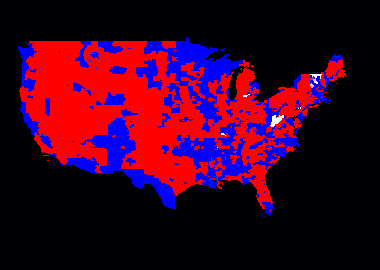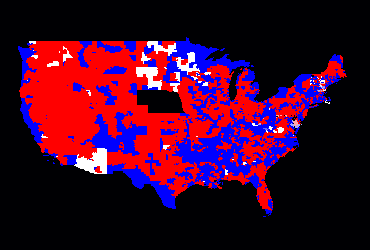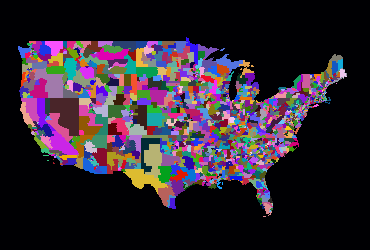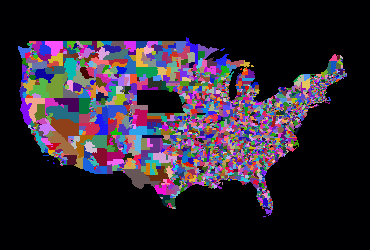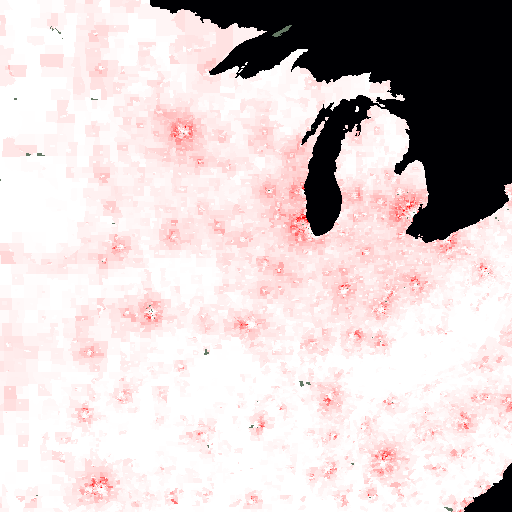10.26.09
Canadian stimulus infrastructure leaving Québec out
Update: Some of the ridings were assigned to neighbouring ridings due to losing some precision in the input lat/lng. This did not make a big difference in the overall picture, as only 2.7% of the projects were classified incorrectly. I’ve updated this blog posting and the map; we probably won’t update the spreadsheet unless we have strong requests to do so.
There has been a fair amount of press lately on the distribution of Canadian stimulus money, with most of what we’d heard saying that Conservative ridings were getting more than their fair share of stimulus money e.g. The Globe and Mail’s Stimulus Program favours Tory ridings. Conservatives countered that it was important to look at the big picture, and that there were multiple stimulus programs. The National Post’s Liberal, NDP ridings getting more than fair share of infrastructure money: analysis reported that non-conservative ridings were getting more than their fair share of the Knowledge Infrastructure Program grants.
My husband and I kind of looked at each other and said, “We can analyze that data!”, so we did. We saw a bias in Conservative/non-Conservative ridings, but it wasn’t huge. We found that Conservative ridings got 51% of the projects, while only 46% of the ridings are Conservative. NDP ridings got 15% of the projects, despite only having 12% of the ridings, and even liberals got slightly more than “their fair share”, with 27% of the projects and only 25% of the ridings.
So who is getting less? The Bloc Québécois. With 15% of the ridings, the Bloc only got 6% of the projects.
If you look at the breakdown by province, it looks like Ontario is getting way, WAY more than its fair share, with some other provinces — especially Québec — getting less than their fair share.
| Province | % of projects | % of population |
|---|---|---|
| AB | 6.71 | 11 |
| BC | 9.2 | 13 |
| MB | 3.81 | 3.6 |
| NB | 3.05 | 2.2 |
| NF | 3.33 | 1.5 |
| NS | 4.20 | 1.8 |
| NT | 0.55 | .13 |
| NU | 0.39 | .094 |
| ON | 53.0 | 39 |
| PE | 1.7 | .42 |
| QC | 8.2 | 23 |
| SK | 5.26 | 3.1 |
| YT | 0.53 | 0.1 |
Dollar values are much harder to estimate because the value of each of the projects is given as a range — “under $100K”, “between $100K and $1M”, etc. We made our best guesses at how to calculate that, and our best estimate gives Québec 12% of the dollars for 23% of the population — better, but still way less than they should be getting.
Now, there might be some errors in the data, as described below. However, we think that this is worth investigation, and soon.
If you would like to look at the data yourself, Jim put together a spreadsheet in Open Office format, a slightly less-powerful spreadsheet in Excel format, and a PDF showing information from the spreadsheet, available on his writeup of the data. I of course made a map of the data.
Caveats:
- We are in no way affiliated with the Government of Canda or Statistics Canada. This analysis does not represent government policy.
- There are multiple parts to the stimulus package, and this analysis only covers the infrastructure component. Other money in the stimulus plan is going towards improving the financial system (which I think means “bank bailouts”, but I’m not sure), extending unemployment benefits, etc.
- I assigned ridings based on the latitudes and longitudes that were given in the Economic Action Plan’s data (which Jim pulled down using their API). We have some doubts about the integrity of those lat/long pairs, especially since two of the stimulus projects have lat/longs that are unquestionably in the United States.
- My software truncated the latitude and longitude used to assign ridings down to two digits, which means the points can appear a little bit to the east and/or south of their actual location. In cases where a point is very near a riding border, that could mean that it would be assigned to the neighbouring riding. I expect this would only affect a very few ridings, and would not significantly affect the by-province counts. This made absolutely no difference in the riding assignment. Update: 174 ridings were mis-assigned, but this did not make a huge difference in the aggregate numbers. It meant that Conservative ridings got 51.1% of the projects instead of 52%, and Quebec got 8.2% instead of 8.6%. The message stays the same: there is inequity here.
- It might be that some national projects are assigned a lat/lng in Ontario because there wasn’t an obvious locus for the project. However, if that were the case, then I would expect that Ottawa would have the biggest number of projects. In fact, the most projects (144) are in the Vaughn riding in Toronto, represented by MP Hon. Maurizio Bevilacqua (L). The Ottawa Centre riding does have the second-highest, but only 101 projects out of the 6424 projects — not enough to explain why QC has so few projects.
Copyrights:
- Information on the stimulus project information came from Canada’s Economic Action Plan
- Canadian federal riding geometries came from Elections Canada, which requires this notice: © The federal Electoral Districts Boundaries (Representation Order 2003), Elections Canada. All rights reserved. Reproduced with the permission of Elections Canada, Ottawa, Ontario K1A 0M6 Canada (2007).
- Information on Canadian MPs came from the House of Commons Web site and were produced by the Government of Canada. The right to reproduce for non-commercial use is given here.
- Provincial population figures came from Statistics Canada.
Update: I looked at per-capita figures, and that makes things look even more skewed. Five of the top ten ridings in projects per hundred thousand people are in Ontario:
| Kenora, ON | 132.211 | |
| Algoma—Manitoulin—Kapuskasing, ON | 124.42 | |
| Yukon, YT | 111.94 | |
| Parry Sound—Muskoka, ON | 101.90 | |
| Ottawa Centre, ON | 92.37 | |
| Egmont, PEI | 91.91 | |
| Vaughan, ON | 91.44 | |
| Nunavut, NU | 84.82 | |
| Western Arctic, NT | 84.41 | |
| Labrador, NL | 79.65 |
The top riding in Quebec, by comparison, ranks 82th out of 308 ridings (at 29.9 projects per hundred thousand people).
(Note that ridings have roughly between 25 and 125 thousand people, with the average right around one hundred thousand.)
